In the depth of sommer it would be a little bit late to write that stripes gonna be the trend this summer. I do not plan to do it. Not only this summer but it's stylish (or not, you'll see) for a hundred years to wear the crowd of parallel lines on your body, that's why I guess there's noone who hasn't got any of them in her/his closet. But what is this everlasting stripe-mania?
Kicsit késő lenne nyár közepén arról írni, hogy nyáron a csíkos lesz a trendi. Nem is áll szándékomban. Nem csak idén nyáron, hanem már vagy száz éve sikk (vagy nem, majd meglátod) párhuzamos vonalak sokaságával borítani testünket, ezért nem is hiszem, hogy van olyan ember, akinek nincs legalább egy darab a gardróbjában belőle. De mi ez a szűnni nem akaró csíkmánia?
Kicsit késő lenne nyár közepén arról írni, hogy nyáron a csíkos lesz a trendi. Nem is áll szándékomban. Nem csak idén nyáron, hanem már vagy száz éve sikk (vagy nem, majd meglátod) párhuzamos vonalak sokaságával borítani testünket, ezért nem is hiszem, hogy van olyan ember, akinek nincs legalább egy darab a gardróbjában belőle. De mi ez a szűnni nem akaró csíkmánia?

Actually I was thinking about why striped motif survives every season, why it appears again and again in the collections, why it is eternal, why we never get bored of it, why it is classic and modern in the same time, why everybody wear it, and why it is still not old-fashioned. Its greatness is in its simpleness: if you want it's unperceivable, if you want it's garish. It can fade into a set and with its wispy fancy to complete that, and it stands its ground too as an archmotif coruscating as the uncrowned king of your look.
Valóban elgondolkodtató, hogy a csíkos minta miért él túl minden szezont, miért bukkan fel újra és újra a kollekciókben, miért tud örökös maradni, miért nem unjuk meg soha, miért klasszikus és modern is egyben, miért hordja mindenki, és miért nem ciki sohasem. Nagyszerűsége éppen egyszerűségében rejlik: ha akarjuk észrevehetetlen, ha akarjuk feltűnő. Épp úgy bele tud olvadni egy szettbe, és leheletfinom extraságával kiegészíteni azt, mint ahogyan főmotívumként is bármikor megállja a helyét megjelenésünk koronázatlan királyaként tündökölve.
Valóban elgondolkodtató, hogy a csíkos minta miért él túl minden szezont, miért bukkan fel újra és újra a kollekciókben, miért tud örökös maradni, miért nem unjuk meg soha, miért klasszikus és modern is egyben, miért hordja mindenki, és miért nem ciki sohasem. Nagyszerűsége éppen egyszerűségében rejlik: ha akarjuk észrevehetetlen, ha akarjuk feltűnő. Épp úgy bele tud olvadni egy szettbe, és leheletfinom extraságával kiegészíteni azt, mint ahogyan főmotívumként is bármikor megállja a helyét megjelenésünk koronázatlan királyaként tündökölve.
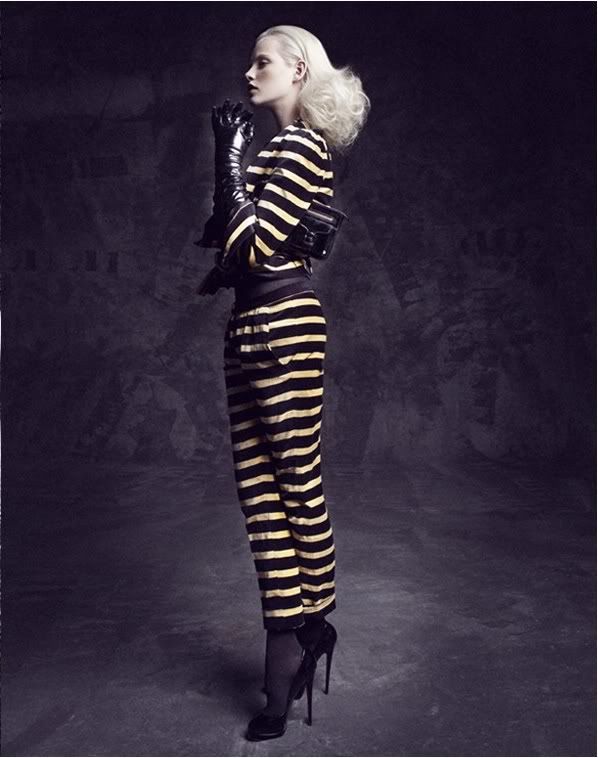
The striped is the yin and yang of the motifs, the perfect harmony of contrasts, the primary form of geometry, the embodiment of parallel perfection, the most minimal shape. Stripes are rebel. The design variations of it on clothes are limitless, that's why it can't be worn-out, either in the classical black(blue)-white, or in XXI. century style we use it.
A csíkos a minták jin és jangja, az ellentétek tökéletes harmóniája, a geometria elsődleges formációja, a párhuzamos tökéletesség megtestesítése, a legminimalistább figura. A csíkos maga a lázadás. Ruhára aplikált variációinak száma szinte végtelen, ezért is olyan elcsépelhetetlen, akár klasszikus fekete(kék)-fehér, akár XXI. századi stílusban használjuk.
Sonia Rykiel for KronKron.A csíkos a minták jin és jangja, az ellentétek tökéletes harmóniája, a geometria elsődleges formációja, a párhuzamos tökéletesség megtestesítése, a legminimalistább figura. A csíkos maga a lázadás. Ruhára aplikált variációinak száma szinte végtelen, ezért is olyan elcsépelhetetlen, akár klasszikus fekete(kék)-fehér, akár XXI. századi stílusban használjuk.
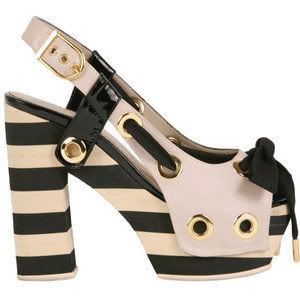
The striped motif is one of the milestones of style, unambiguously its basic piece. How stripes came a determining long way it shows that about its history there's a book called The Devil's Cloth: A History of Stripes by Michel Pastoureau.
A csíkos minta a stílus egyik mérföldköve, mára egyértelműen alapdarabja. Hogy a csíkos minta mennyire meghatározó utat járt be, más sem mutatja jobban, mint hogy történetéről könyv is született, egészen pontosan Michel Pastoureau The Devil's Cloth: A History of Stripes című irománya.
A csíkos minta a stílus egyik mérföldköve, mára egyértelműen alapdarabja. Hogy a csíkos minta mennyire meghatározó utat járt be, más sem mutatja jobban, mint hogy történetéről könyv is született, egészen pontosan Michel Pastoureau The Devil's Cloth: A History of Stripes című irománya.
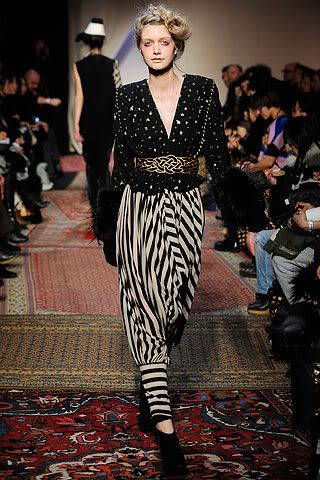
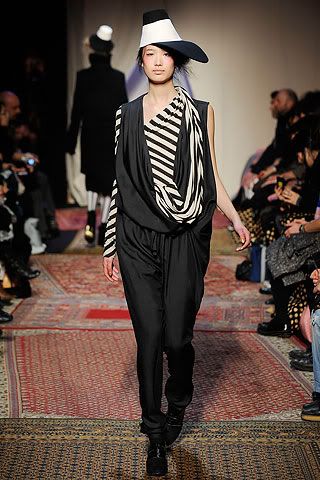
✄ I have to make a confess: I am totally in love with Tsumori Chisato Fall 2010 Ready-To-Wear collection! It reminds me of the the Arabian Nights and the luxury sheikh world, shotted with the dynamic linelead of modernism. The legionary Mrs. Jean-Claude Van Damme, gypsies and circus performers, and the owerwhelming feathery which reminiscent of the 20's coupling with curtainbraids, flimsy materials and shiny "heavy" gems. Multifarious of the patterns and the absolute congestion of them mark this (I rarely use this word but) marvelous (I guess rather spring/summer) collection. Tsumori Chisato is my hero!
✄ Be kell vallanom, totál odavagyok Tsumori Chisato 2010-es Őszi RTW kollekciójáért. Az Ezeregyéjszaka meséit és a luxus sejkvilágot juttatja eszembe, mindezt a modernizmus dinamikus vonalvezetésével átszőve. A légiós Jean-Claude Van Damme-né, cigányok és cirkuszosok, és a 20-as éveket idéző elmaradhatatlan tollak párosulnak a függönyzsinórokkal, lenge anyagokkal és a csillogó "nehéz" kövekkel. Minták ezerarcúsága és teljes nyúfoltsága jellemzi ezt a (ritkán használom ezt a szót, de) csodálatos (szerintem inkább tavaszi/nyári) kollekciót. Tsumori Chisato az én hősöm!
Tsumori Chisato Fall/Winter 2010/2011 Show at Paris.✄ Be kell vallanom, totál odavagyok Tsumori Chisato 2010-es Őszi RTW kollekciójáért. Az Ezeregyéjszaka meséit és a luxus sejkvilágot juttatja eszembe, mindezt a modernizmus dinamikus vonalvezetésével átszőve. A légiós Jean-Claude Van Damme-né, cigányok és cirkuszosok, és a 20-as éveket idéző elmaradhatatlan tollak párosulnak a függönyzsinórokkal, lenge anyagokkal és a csillogó "nehéz" kövekkel. Minták ezerarcúsága és teljes nyúfoltsága jellemzi ezt a (ritkán használom ezt a szót, de) csodálatos (szerintem inkább tavaszi/nyári) kollekciót. Tsumori Chisato az én hősöm!
According to Cameron Norrie's review of Michel Pastoureau's The Devil's Cloth: A History of Stripes book: "Pastoureau describes the medieval period's tendency to use stripes to identify those viewed as outcasts in society, including: serfs, the condemned, prostitutes, jugglers, clowns, hangmen, Jews, lepers, cripples, bohemians, and heretics. The negative, or evil, stripe also appears in iconography and literary texts, worn by: treacherous knights, adulterous wives, disloyal brothers, cruel dwarves, greedy servants, Lucifer, the madman of the Book of Psalms, and Judas. A fascinating illustration included in the book, from a mural in Italy painted around 1340, depicts three young women condemned to prostitution saved by Saint Nicolas - all three in striped garments. In 1254, when monks of the Carmelite Order returned from the Holy Land in striped cloaks, scandal broke out - they were ridiculed and accused of being in league with the Antichrist. The wearing of striped habits for all religious orders was banned. In 1310 a 'cobbler said to be a cleric' was sentenced to death for being married and being 'caught in striped clothes.' Pastoureau follows the stripe through history, as it is associated with servants, then later as revolutionary during the French Revolution. The punishing and degrading stripe reserved for prisoners, was again used by the Nazis in the concentration camps. Along all these vicious or negative stripes, good stripes also began to appear: a celebratory stripe, a romantic stripe, a seaside stripe, a children's stripe (sailor suits and Obelix!), an athletic stripe and a hygienic stripe." (Read the whole review here!)
Egy részlet Cameron Norrie könyvismertetőjéből, melyet Michel Pastoureau The Devil's Cloth: A History of Stripes című művéből írt: "Pastoureau leírja, miszerint a középkori tendencia szerint, azok viseltek csíkosat, akiket a társadalomból kitaszítottnak bélyegeztek, mint a jobbágyok, a halálraítéltek, a prostituáltak, a zsonglőrök, a bohócok, a hóhérok, a zsidók, a leprások, a nyomorékok, a bohémok és az eretnekek. A negatív vagy gonosz csíkozás feltűnik az ikonográfiában és az irodalmi szövegekben is, és ezekből kiderül, hogy az áruló lovagok, a házasságtörő feleségek, a hűtlen fivérek, a kegyetlen törpék, a kapzsi szolgák, Lucifer, a Zsoltárok Könyvének őrültje, és Júdás is viselték. Egy magával ragadó illusztráció is megtalálható a könyvben, egy freskó Olaszországból az 1340 körüli évekből, mely három fiatal nőt ábrázol, akiket prostitúció vádjával bélyegeztek meg - mind csíkos öltözetben. 1254-ben, amikor a Kármelita Rend szerzetesei visszatértek a Szent Földről csíkos köpenyeikben, botrány tört ki - gyúnyt űztek belőlük és megvádolták őket, hogy az Antikrisztussal léptek szövetségre. Mindenféle csíkos ruha viseletét, vallásos indokokra hivatkozva betiltották. 1310-ben egy lelkészt halálra ítéltek, amiért házasságon és csíkos ruha viseletén kapták. Pastoureau tovább követi a csíkos minta útját a történelmen keresztül, ahogy továbbra is szolgákkal kötik össze, majd később, mint forradalmi viselet a Francia Forradalom idején. Majd rabok számára fenntartott büntető és megalázó ruha lett, és a nácik is használták a koncentrációs táboraikban. A romlott és negatív csíkok mellett megjelent pozitív változatuk is, mint például az ünnepi, a romantikus, a tengerparti, a gyermeki (tengerészruha és Obelix!), az atlétikai és az egészségügyi csíkozás is." (Olvasd el az egész könyvajánlót itt!)
Egy részlet Cameron Norrie könyvismertetőjéből, melyet Michel Pastoureau The Devil's Cloth: A History of Stripes című művéből írt: "Pastoureau leírja, miszerint a középkori tendencia szerint, azok viseltek csíkosat, akiket a társadalomból kitaszítottnak bélyegeztek, mint a jobbágyok, a halálraítéltek, a prostituáltak, a zsonglőrök, a bohócok, a hóhérok, a zsidók, a leprások, a nyomorékok, a bohémok és az eretnekek. A negatív vagy gonosz csíkozás feltűnik az ikonográfiában és az irodalmi szövegekben is, és ezekből kiderül, hogy az áruló lovagok, a házasságtörő feleségek, a hűtlen fivérek, a kegyetlen törpék, a kapzsi szolgák, Lucifer, a Zsoltárok Könyvének őrültje, és Júdás is viselték. Egy magával ragadó illusztráció is megtalálható a könyvben, egy freskó Olaszországból az 1340 körüli évekből, mely három fiatal nőt ábrázol, akiket prostitúció vádjával bélyegeztek meg - mind csíkos öltözetben. 1254-ben, amikor a Kármelita Rend szerzetesei visszatértek a Szent Földről csíkos köpenyeikben, botrány tört ki - gyúnyt űztek belőlük és megvádolták őket, hogy az Antikrisztussal léptek szövetségre. Mindenféle csíkos ruha viseletét, vallásos indokokra hivatkozva betiltották. 1310-ben egy lelkészt halálra ítéltek, amiért házasságon és csíkos ruha viseletén kapták. Pastoureau tovább követi a csíkos minta útját a történelmen keresztül, ahogy továbbra is szolgákkal kötik össze, majd később, mint forradalmi viselet a Francia Forradalom idején. Majd rabok számára fenntartott büntető és megalázó ruha lett, és a nácik is használták a koncentrációs táboraikban. A romlott és negatív csíkok mellett megjelent pozitív változatuk is, mint például az ünnepi, a romantikus, a tengerparti, a gyermeki (tengerészruha és Obelix!), az atlétikai és az egészségügyi csíkozás is." (Olvasd el az egész könyvajánlót itt!)
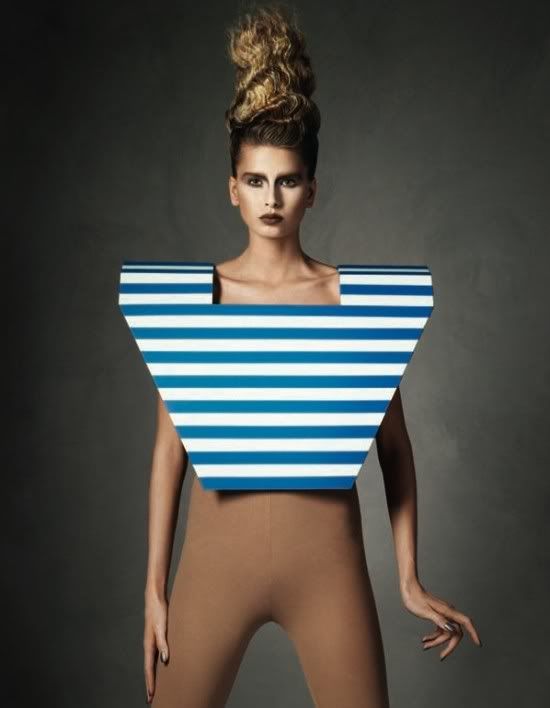
I think it is impossible to display the multitude of variations. We have seen stripes in every material and colour, from pants to pins, in every piece. Now, when summer's rumping and there's thousands degrees, I have chosen these two shirts by Alexander Wang from the Spring 2010 Ready-To-Wear collection. Next to the stripes there are two other "new" madness, the belly shirt and the socks + sandal couple (in this case though those are not sandals, but we're talking about summer, this is socks + shoes, so this is about the same thing). About this two (I think superb) (and not really new) trend (which fuels the debate about it) later I gonna care for.
A változatok sokaságát azt hiszem, képtelenség lenne bemutatni. Már minden anyagban és színben láttunk csíkosat, bugyitól a kitűzőig, minden darabban. Most, mivel tombol a nyár és százezer fok van, ezt a két Alexander Wang darabot válaszottam a 2010-es Tavaszi Ready-To-Wear kollekcióból. A csíkok mellett két "új" őrület is megmutatkozik, a haspóló és a zokni + szandál párosítás (ez esetben ugyan nem szandál, de nyárról beszélünk, zokni + cipő párosítás, tehát kb. ugyan az jelen esetben). Erről a két (szerintem szuper) (és nem éppen új keletű) trendről (mely éles vitákat is szül), később még szót ejtek.
A változatok sokaságát azt hiszem, képtelenség lenne bemutatni. Már minden anyagban és színben láttunk csíkosat, bugyitól a kitűzőig, minden darabban. Most, mivel tombol a nyár és százezer fok van, ezt a két Alexander Wang darabot válaszottam a 2010-es Tavaszi Ready-To-Wear kollekcióból. A csíkok mellett két "új" őrület is megmutatkozik, a haspóló és a zokni + szandál párosítás (ez esetben ugyan nem szandál, de nyárról beszélünk, zokni + cipő párosítás, tehát kb. ugyan az jelen esetben). Erről a két (szerintem szuper) (és nem éppen új keletű) trendről (mely éles vitákat is szül), később még szót ejtek.
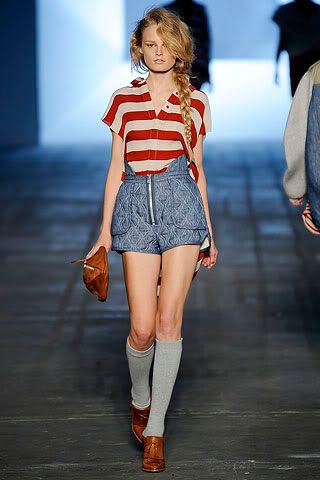

This wedge of Charlotte Olympia, the striped dress of Moschino Fall 2010 Ready-To Wear collection or the sailor shirt of Mads Norgaard Spring 2010 Men's collection is the sample for that classical striped pattern will probably appear in the next years, decades and flourish again and again that we can admire the greatness of its simpleness...
Charlotte Olympia telitalpú magassarkúja, a Moschino 2010-es Őszi Ready-To-Wear kollekció csíkos kisruhája vagy Mads Norgaard 2010-es Tavaszi férfikollekciójának matrózpólója a mutatója annak, hogy a klasszikus csík mintázat várhatóan a következő években, évtizedekben is évről évre felbukkan majd és újra meg újra új virágot bont, hogy egyszerűségének nagyszerűségét még sokáig csodálhassuk...
Charlotte Olympia ShoesCharlotte Olympia telitalpú magassarkúja, a Moschino 2010-es Őszi Ready-To-Wear kollekció csíkos kisruhája vagy Mads Norgaard 2010-es Tavaszi férfikollekciójának matrózpólója a mutatója annak, hogy a klasszikus csík mintázat várhatóan a következő években, évtizedekben is évről évre felbukkan majd és újra meg újra új virágot bont, hogy egyszerűségének nagyszerűségét még sokáig csodálhassuk...
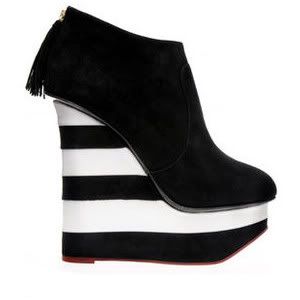
Amy Finlayson by Mikael Wardhana, photo by Marcin Tyszka for Vogue Portugal, in Dazed & Confused, runway photos from style.com


4 comment(s):
A csíkos minta tényleg nem megy ki a divatból!
Michel Pastoureau The Devil's Cloth: A History of Stripes című könyvét szívesen elolvasnám, nagyon érdekesnek hangzik! Charlotte Olympia cipőinek minden egyes darabjáért odavagyok, és ez alól a csíkos telitalpú sem kivétel (Rihanna is ilyet vilselt)!
Your blog is truely amazing, I love the way you write and you seem to have a great sense of style !
xx
thank you! :)
I comletly agree. Realy great style and good writing. What else could u want from a blog? :-)
M
****************
http://mayabeus.blogspot.com/
Post a Comment